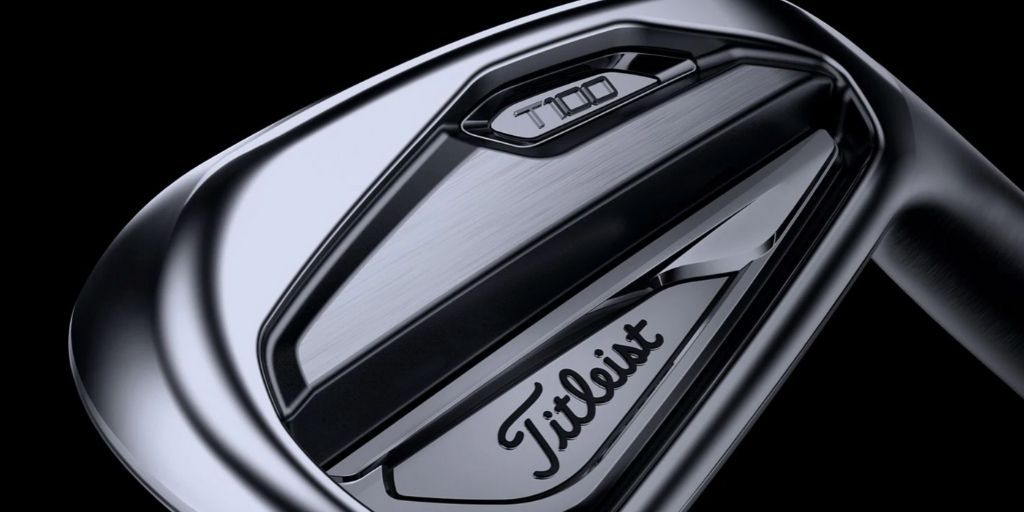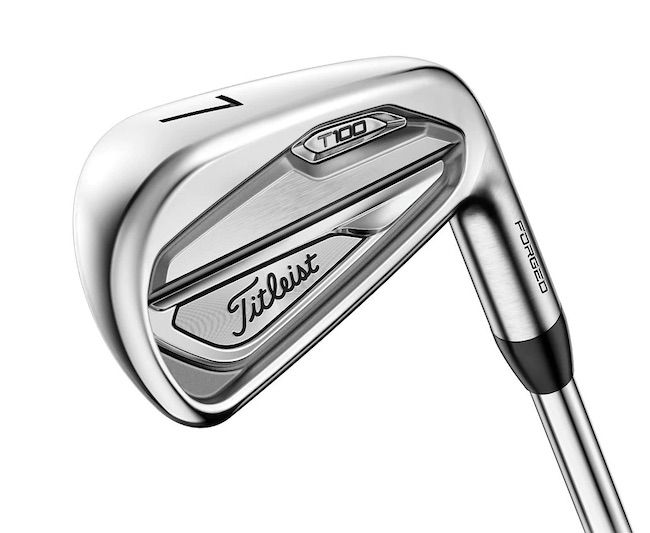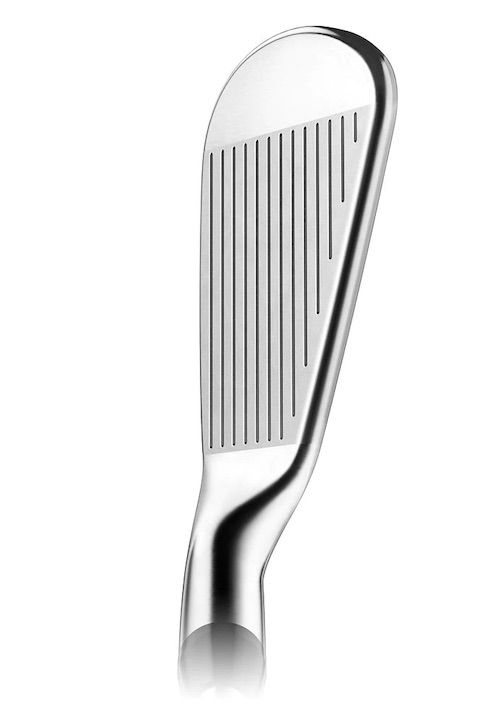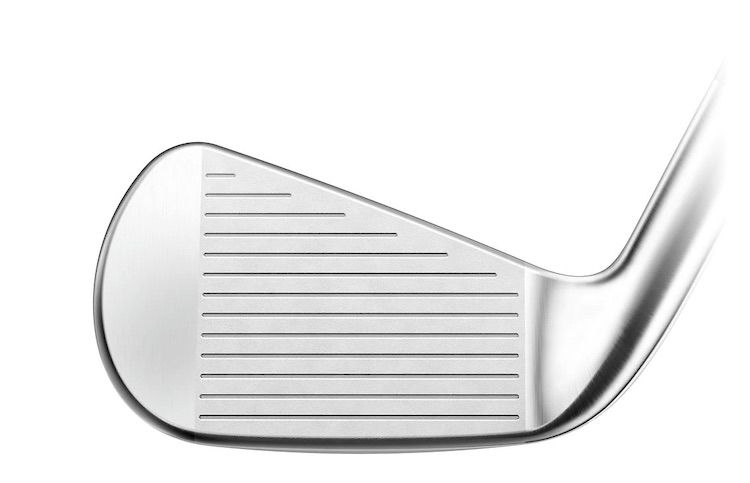
The AP line from Titleist is no more. New and improved for 2020 is the T-series family of irons. In this article, I'll explore the T100, which is the smallest and most "blade-like" model in the lineup.
The renumbering can be slightly confusing as the T100 is a replacement model for the former forged cavity iron, the AP2. But I'll clear all of that up for you! The positive here is that now the models are sequential:
- T100 (most blade-like, replaces AP2)
- T200 (more forgiving forging with stronger lofts, still with a traditional look, replaces AP3)
- T300 (larger cast head, higher launching, more offset, more forgiveness, replaces AP1)
After testing the Titleist T100, I'll give you a little bit of info on what they're engineering team was trying to do and what kinds of players these irons are appropriate for.

Starting from the Top
It's not broken, but let's fix it anyway. Before the T100, the Titleist AP2 had been the most played iron model on the PGA Tour for the better part of a decade. So when you are redesigning and rebranding the most used iron model on the PGA Tour, what are you trying to accomplish?
Titleist is known for its focus on high-level amateur and Tour players. The modifications in T100 seem to be true to this emphasis on helping skilled players play their best. Here's how:
- Thin topline: Despite being a beautiful golf club to the eyes of many golfers, the AP2 lines were notably larger on top than traditional MB or CB models. The T100 is much closer to the look of the MB/CB top lines. Comparing the pitching wedges side by side, they look nearly identical.
- Superior Turf Interaction: The sole of the T100 is narrower than the previous (or any) model AP2. The leading edge is also pre-worn and slightly beveled to help the club glide into the turf on both steeper and shallower strikes. Versatility was the design goal.
- Minimal Offset: While the T100 irons have more offset than the Titleist MB or CB Models, it's markedly less than nearly every other iron in the "Player's Iron" category. While we're only talking about fractions of an inch in offset, for a player who doesn't want to see the ball turning too far left (right-handed golfer), minimizing offset is an essential tool for clubfitters.
- Forgiveness: It may appear very similar to a traditional Muscle Back in the playing position, but there's a lot of help hidden under that sleek, shiny hood. Tungsten weighting forged into the extreme heel and toe of the iron significantly increase stability and MOI without any drastic changes to launch or spin. The key here is keeping the weight near the face of the golf club; if the tungsten weights were pulled away from the face, the iron would launch higher, which is something this club head is not aiming to deliver. It's important to note that heel/toe weighting reduces curve in golf shots. While many players want "workability," the modern golfer generally wants to curve the ball less. The T100 can still be curved, just on a smaller scale.
Where the T100 Fits In
Titleist T100 Irons are one of the thinnest, most blade-looking cavity irons on the market. The topline is very thin and clean. The blade length is short, and the lofts are (for this day and age) very traditional. A 46-degree pitching wedge is about as weak you'll find these days, even in a true muscle back blade. This is similar to what I saw in Mizuno's HMB irons.

The T100 are not made to be a game improvement club, nor would I classify it as a "Players Distance Iron," which is a popular emerging category. I would rate this club more as a high-tech cavity-backed blade. The player who will benefit most from this iron is someone who has always played (or always wanted to play) traditional blade irons but now wants to take advantage of the forgiveness that modern technology can offer.

What I've Seen in the Fitting Bay
The players who gravitate towards the T100 are mostly high-level golfers who have plenty of ball speed. I don't like to label handicaps to clubs because I know five handicaps who hit it poorly (play smart and chip and putt like crazy), and 12 handicaps who hit it like scratch players (but take too many risks and putt like Chihuahuas….yippy).
If you're going to miss the center of the clubface 3 or 4 times out of a ten shot pattern, or want to hit seven iron 185 yards, I'm going to steer you towards something that's built with more forgiveness or distance in mind. For folks who can find the center of the scoring lines with regularity, and don't want to carry five wedges, this club is the total package.
(P.S. If you like everything your hearing but want are looking for more distance, Titleist has announced a T100s (strong) set hitting shelves in late March.)

Some Real-Life Examples
Charlie Hoffman has traditionally played a blended set of irons made up of muscle back lower irons and a more forgiving makeup of long irons. After his Fall 2019 fitting with the Titleist Tour Team, he's now bagging T100 irons from top to bottom. I think this is a vote for the clubs' versatility.
More than 50% of the NCAA players I work with have put T100's in the bag. The most common case is a kid who wants something clean looking that is smooth through the ground at high speeds, but who is counting his score every time he goes out to play. He usually comes in wanting a muscle or cavity back blade, but once they see the T100 looking just as pretty and giving them tighter dispersion at basically no cost in look or feel, the decision becomes a no-brainer.
Titleist T100 vs. T200
If you're in between the T100 and T200, the main differences you should consider is forgiveness and loft. The T200 irons have stronger lofts, which make them more appropriate for golfers who are looking for a little more distance with their irons. Additionally, the T200 irons are a bit more forgiving than the T100, but they still have a traditional look. Think of the T200 irons as a replacement for the AP3 model.
T100 vs. AP2
There are a lot of golfers who want to know how the T100 compares to the recent AP2 releases. Here are a couple of things I noticed about the T100:
- Thinner topline on the T100 (think more traditional blade like the MB and CB models)
- Narrower sole
T100 Specs
Here are the lofts for the T100. As I mentioned earlier, these are less aggressive than most modern irons you'll see.
3456789P21°24°27°30°34°38°42°46°
Final Thoughts
Iron fitting has evolved significantly over the past five years. Lie boards are antiquated. Shaft options are vast. And most importantly, our ability to track the ball through the air with radar now enables us to fine-tune not just the launch angle of the ball, but the apex height, spin rate, and landing angle as well.
Fitting irons is not like fitting a driver. Drivers are hit from one lie, with one job; go as far as you can while staying in (or near) the fairway. Irons are used from every lie imaginable, for a wide variety of shots. Don't go into an iron fitting, trying to max out your seven iron clubhead speed. Sure, you should hit some shots hard, but you should also hit punches, knockdowns, cuts, draws, or whatever else you like to do with your clubs. Irons are tools for many jobs, be sure your new set is performing in all facets of the game.
The Titleist T100 are a fantastic set of irons for better ball strikers. If you want the benefits of a traditional blade, but some of the forgiveness that modern technology allows for, you'll likely love them. As always, try before you buy. Work with a qualified clubfitter if you can! Another iron you could consider is the Callaway X Forged CB.
Also, you can check out my review of the Titleist TSi drivers here.
If you're interested in learning more about clubfitting, you can also read my iron fitting guide.
We care about the protection of your data Read our Privacy Policy